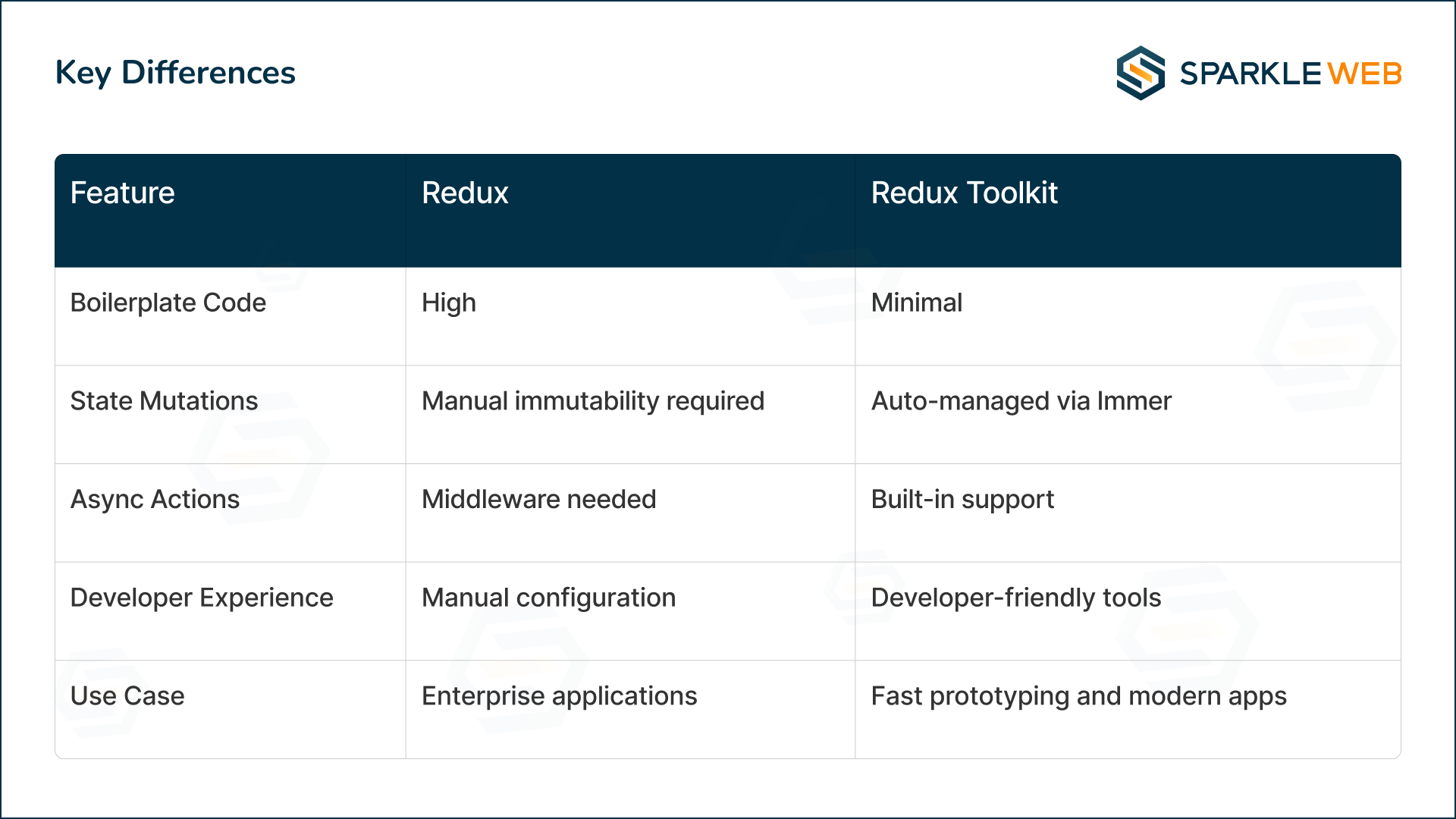In 2024, managing the application state remains one of the most important aspects of building modern React applications. Two tools—
Redux and
Redux Toolkit—are popular choices for developers when it comes to state management. Redux has been around for years and is widely known for its reliability and flexibility. However, Redux Toolkit, the official modern version of Redux, has gained attention for being more user-friendly and efficient.
Choosing the right tool for your project depends on factors like the size of the application, the experience level of your development team, and your project goals. Let’s dive into the details to understand the differences between these tools and how they can help you achieve the best results for your project.
Why Does State Management Matter?
In React applications, state management refers to the way data is handled across components. As applications grow in complexity, managing the state becomes more challenging. Redux and Redux Toolkit help developers manage this complexity by providing a structured way to handle state changes, making applications easier to maintain and scale.
Comparing Redux and Redux Toolkit
Both tools serve the same purpose—state management—but they approach it differently. Let’s explore their advantages, disadvantages, and real-world use cases.
Advantages of Redux
1. Proven Track Record
Redux has been a trusted tool for many years. It is widely used in enterprise applications and has a strong community that provides plenty of resources and support.
2. Fine-Grained Control
Redux gives developers complete control over actions, reducers, and middleware. This makes it suitable for applications with very specific requirements.
3. Scalability
Redux is a great choice for large-scale projects because of its flexibility and ability to integrate with custom middleware like redux-saga or redux-thunk.
Advantages of Redux Toolkit
1. Less Boilerplate Code
Redux Toolkit simplifies the development process by reducing repetitive code. It combines actions, reducers, and initial state into a single function using createSlice.
2. Built-In Features
It comes with built-in tools for handling asynchronous operations, such as createAsyncThunk, eliminating the need for additional middleware.
3. Modern and Developer-Friendly
Redux Toolkit includes tools like Immer, which allow developers to write code that looks mutable while maintaining immutability under the hood. This makes it easier and faster to work with state updates.
4. Quick Prototyping
Redux Toolkit is ideal for startups or smaller teams that want to develop applications quickly without sacrificing quality.
Disadvantages of Redux
1. More Code to Write
Redux requires developers to write action types, action creators, and reducers separately. This can feel repetitive and time-consuming, especially for simple projects.
2. Steep Learning Curve for Beginners
Understanding concepts like middleware, action creators, and reducers can be challenging for new developers.
3. No Built-In Async Handling
Developers must use additional middleware like redux-thunk or redux-saga to handle asynchronous operations.
Disadvantages of Redux Toolkit
1. Less Control for Advanced Use Cases
Redux Toolkit abstracts away many details, which might not be ideal for developers who need fine-grained control.
2. Learning Curve for Experienced Redux Users
Developers who are already familiar with Redux may need time to adjust to the new approach in the Redux Toolkit.
Code Examples: Redux vs Redux Toolkit
To understand the differences, let’s look at how each tool handles basic tasks like creating actions and reducers.
Using Redux (Traditional Approach)
// Action Types
const INCREMENT = 'INCREMENT';
const DECREMENT = 'DECREMENT';
// Action Creators
export const increment = () => ({ type: INCREMENT });
export const decrement = () => ({ type: DECREMENT });
// Reducer
const initialState = { count: 0 };
export const counterReducer = (state = initialState, action) => {
switch (action.type) {
case INCREMENT:
return { ...state, count: state.count + 1 };
case DECREMENT:
return { ...state, count: state.count - 1 };
default:
return state;
}
};
Using Redux Toolkit
import { createSlice } from '@reduxjs/toolkit';
const counterSlice = createSlice({
name: 'counter',
initialState: { count: 0 },
reducers: {
increment: (state) => { state.count += 1; },
decrement: (state) => { state.count -= 1; }
}
});
export const { increment, decrement } = counterSlice.actions;
export default counterSlice.reducer;
Key Differences

Real-World Scenarios
When to Use Redux
-
Best for large-scale, enterprise applications where you need fine control over state and middleware.
-
Example: A legacy system that uses redux-saga to handle complex workflows.
When to Use Redux Toolkit
Why Developers Love Redux Toolkit in 2024
In 2024, the Redux Toolkit is gaining popularity because it aligns with modern development practices. By reducing the amount of boilerplate code and integrating features like asynchronous handling, it allows developers to focus on building applications rather than managing the state manually.
Challenges with Both Tools
1. For Beginners
New developers might find concepts like reducers, actions, and immutability difficult to grasp. Including beginner-friendly examples can help.
2. Staying Competitive
Many blogs and tutorials already cover these tools. To stand out, focus on providing real-world examples and clear comparisons.
3. Need for Visuals
Adding flowcharts or diagrams to explain Redux’s data flow can make the content more engaging and easier to understand.
Conclusion
At Sparkle Web, we specialize in both Redux and Redux Toolkit. Whether you’re working on a complex enterprise project or a quick prototype, our experienced team can help you choose the right tool and implement it effectively.
Looking for help with your React project? Let Sparkle Web handle your state management needs. Contact us today, and let’s build something amazing together!




Vaishali Gaudani
Skilled React.js Developer with 3+ years of experience in creating dynamic, scalable, and user-friendly web applications. Dedicated to delivering high-quality solutions through innovative thinking and technical expertise.
Reply